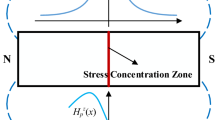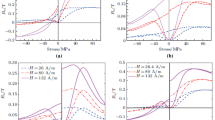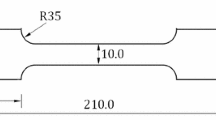Abstract
Metal magnetic memory (MMM) method is a novel, passive magnetic method for inspecting mechanical degradation of ferromagnetic components. To promote a further understanding of the relation between the magnetic characteristics and mechanical deformation, the normal spontaneous stray field component and its gradient of Q235-steel specimens were measured during uniaxial tensile and compressive loading processes. The results show that the normal spontaneous stray field component and its gradient are effective in capturing different deformation stages under tensions, but no detectable change can be found during the whole compressive loading processes. Compared with the amplitude of the normal spontaneous stray field component, the gradient is a more sensitive parameter. In addition, the result demonstrates that it is easy to differentiate macro-crack and plastic deformation because the differences among measured spontaneous stray field signals are obvious. Moreover, various factors affecting test results were also considered.












Similar content being viewed by others
References
Bozorth RM, Williams HJ (1945) Effect of small stress on magnetic. Properties Rev Mod Phys 17:72–80
Chikazumi S (1964) Physics of magnetism. Wiley, New York
ASTM international (1989) Nondestructive evaluation and quality control. Vol.17. ASM Handbook
Blitz J (1991) Electrical and magnetic methods of nondestructive testing. Adam Hilger IOP Publishing, Ltd., Bristol
Jiles D (1998) Introduction to magnetism and magnetic materials. 2nd edition. Chapman and Hall
Jagadish C, Clapham L, Atherton DL (1990) Influence of uniaxial elastic stress on power spectrum and pulse height distribution of surface Barkhausen noise in pipeline steel. IEEE Trans Magn 26(3):1160–1163
Lindgren M, Lepistö T (2003) Relation between residual stress and Barkhausen noise in a duplex steel. NDT&E Int 36:279–288
Sablik MJ, Augustyniak B (2000) Modeling the magnetic field dependence of magnetoacoustic emission. Mater Eval 58:655–660
Tomas I (2004) Non-destructive magnetic adaptive testing of ferromagnetic materials. J Magn Magn Mater 268:178–185
Doubov AA (1998) Screening of weld quality using the metal magnetic memory. Weld world 41:196–199
Doubov AA (1999) Diagnostics of metal items and equipment by means of metal magnetic memory, in: Proc of CHSNDT 7th Conference on NDT and International Research Symposium. Non-Destructive Testing Institution, CEMS, Shantou China, pp 181–187
Ren JL, Song K, Wu GH, Lin JM (2001) Mechanism study of metal magnetic memory testing, Proceedings of the 10th Asia-Pacific Conference on Non-Destructive Testing Brisbane, Australia, 17–21 September
Iordache VE, Hug E, Buiron N (2003) Magnetic behaviour versus tensile deformation mechanisms in a non-oriented Fe-(3 wt.%)Si steel. Mater Sci Eng A 359(1–2):62–74
Dong LH, Xu BS, Dong SY, Chen QZ, Wang YY, Zhang L (2005) Metal magnetic memory testing for early damage assessment in ferromagnetic materials. J Cent South Univ Technol 12(S2):102–106
Wang X, Chen M, Xu BS (2007) Change of magnetic memory signals during the tension–compression fatigue of 48MnV steel. China Mech Eng 18(15):1862–1864
Roskosz M, Gawrilenko P (2008) Analysis of changes in residual magnetic field in loaded notched samples. NDT&E Int 41:570–576
Doubov AA (2004) Principal features of metal magnetic memory method and inspection tools as compared to known magnetic NDT methods. Proceedings of the 16th Annual World Conference on Non-Destructive Testing. Montreal, Canada
Cullity BD (1972) Introduction to magnetic marerials. Addison-Wesley Publishing company, New York
Jiles DC, Atherton DL (1986) Theory of ferromagnetic hysteresis. J Magn Magn Mater 61:48–60
Sablik MJ, Burkhardt GL, Kwun H, Jiles DC (1988) A model for the effect of stress on the low frequency harmonic content of the magnetic induction in ferromagnetic materials. J Appl Phys 63:3930–3932
Kaminski DA, Jiles DC, Sablik MJ (1992) Angular dependence of the magnetic properties of polycrystalline iron under the action of uniaxial stress. J Magn Magn Mater 104:382–384
Richard HM, Harvey R, Robert JS (1971) Magnetostrictive phenomena in metallic materials and some of their device applications. IEEE Trans Mag 7(1):29–48
Gatelier-Rothea C, Chicois J, Fougeres R, Fleischmann P (1998) Characterization of pure iron and (130 P.P.M.) carbon–iron binary alloy by Barkhausen noise measurements: study of the influence of stress and microstructure. Acta Mater 46(14):4873–4882
Stefanita CG, Atherton DL, Clapham L (2000) Plastic versus elastic deformation effects on magnetic Barkhausen noise in steel. Acta Mater 48:3545–3551
Wang ZD, Deng B, Yao K Physical model of plastic deformation on magnetization in ferromagnetic materials. J Appl Phys D (accepted)
Doubov AA, Vstovsky GV (2000) Physical base of the method of metal magnetic memory. Moscow
Dong LH, Xu BS, Dong SY, Chen QZ, Wang YY, Zhang L (2009) Stress dependence of the spontaneous stray field signals of ferromagnetic steel. NDT & E Int 42:323–327
Leng JC, Xu MQ, Xu MX, Zhang JZ (2009) Magnetic field variation induced by cyclic bending stress. NDT&E International 42:410–414
Shi CL, Dong SY, Xu BS, He P (2010) Metal magnetic memory effect caused by static tension load in a case-hardened steel. J Magn Magn Mater 322(4):413–416
Shi CL, Dong SY, Xu BS, He P (2010) Stress concentration degree affects spontaneous magnetic signals of ferromagnetic steel under dynamic tension load. NDT&E Int 43(1):8–12
Wang ZD, Yao K, Ding KQ (2010) Theoretical studies of metal magnetic memory technique on magnetic flux leakage signals. NDT&E Int 43(4):354–359
Wang ZD, Yao K, Ding KQ (2010) Quantitative study of metal magnetic memory signal versus local stress concentration. NDT&E Int 43(6):513–518
Birss RR, Faunce CA, Isaac ED (1971) Magnetomechanical effects in iron and iron-carbon alloys. J Phys D 4:1040–1048
Banks PJ (1975) The effects of some complex systems of stress on dynamic magnetostriction in oriented silicon iron. Ph.D. dissertation, Liverpool Polytechnic, England, pp 81–92
Acknowledgements
This work was funded by Natural Science Foundations of China (No 11072027, 10872025), the Fundamental Research Funds for the Central Universities and Ministry of Education of the People’s Republic of China (NECT).
Author information
Authors and Affiliations
Corresponding author
Rights and permissions
About this article
Cite this article
Yao, K., Wang, Z.D., Deng, B. et al. Experimental Research on Metal Magnetic Memory Method. Exp Mech 52, 305–314 (2012). https://doi.org/10.1007/s11340-011-9490-3
Received:
Accepted:
Published:
Issue Date:
DOI: https://doi.org/10.1007/s11340-011-9490-3




